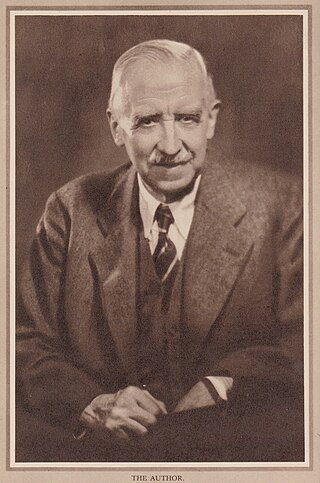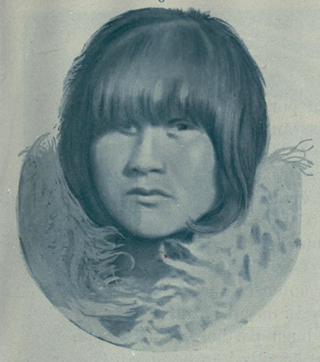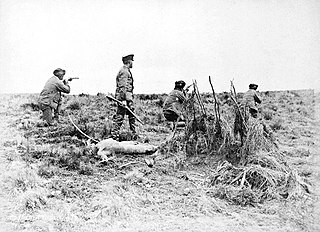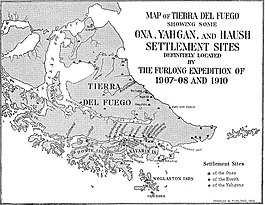
Tierra del Fuego is an archipelago off the southernmost tip of the South American mainland, across the Strait of Magellan.

Tierra del Fuego, officially the Province of Tierra del Fuego, Antarctica and South Atlantic Islands, is the southernmost, smallest, and least populous Argentine province. The provincial capital city is Ushuaia, from a native word meaning "bay towards the end".

The Selk'nam, also known as the Onawo or Ona people, are an indigenous people in the Patagonian region of southern Argentina and Chile, including the Tierra del Fuego islands. They were one of the last native groups in South America to be encountered by migrant Europeans in the late 19th century.

The Yahgan are a group of indigenous peoples in the Southern Cone of South America. Their traditional territory includes the islands south of Isla Grande de Tierra del Fuego, extending their presence into Cape Horn, making them the world's southernmost indigenous human population.

Anne MacKaye Chapman was a Franco-American ethnologist who focused on the people of Mesoamerica writing several books, co-producing movies, and capturing sound recordings of rare languages from the Northern Triangle of Central America to Cape Horn in South America.

Navarino Island is a large Chilean island, with an area of 2,514 km2 (971 sq mi) and a coastline of 510 km (320 mi). It is located between Isla Grande de Tierra del Fuego, to the north, and Cape Horn, to the south. The island forms part of the Commune of Cabo de Hornos, the southernmost commune in Chile and in the world, belonging to Antártica Chilena Province in the XII Region of Magallanes and Chilean Antarctica. Its population is concentrated primarily in the communal capital, Puerto Williams, and in small settlements like Puerto Navarino, Río Guanaco and Puerto Toro. The highest point of the island is Pico Navarino at 1,195 m (3,921 ft). The island is a popular destination for fly-fishers.

Esteban Lucas Bridges was an Anglo-Argentine author, explorer, and rancher. After fighting for the British during the First World War, he married and moved with his wife to South Africa, where they developed a ranch with her brother.
Ona, also known as Selk'nam (Shelknam), is a language spoken by the Selk'nam people in Isla Grande de Tierra del Fuego in southernmost South America.

Alberto de Agostini National Park is a protected area that was created on January 22, 1965, on land that was formerly part of the "Hollanda" forest reserve and "Hernando de Magallanes National Park". It covers 1,460,000 hectares and includes the Cordillera Darwin mountain range, which is the final land-based stretch of the Andes before it becomes a chain of mountains appearing as small islands that sink into the Pacific Ocean and the Beagle Channel.

Fuegians are the indigenous inhabitants of Tierra del Fuego, at the southern tip of South America. The name has been credited to Captain James Weddell, who supposedly created the term in 1822.

Ángela Loij López, baptized as Ángela Gómez, was an Argentine-Chilean woman considered to be the last surviving individual of full-blooded Selk'nam (Ona) descent, an indigenous group that resided in Tierra del Fuego.
The Fuegian languages are the indigenous languages historically spoken in Tierra del Fuego by Native Americans. Adelaar lists the Fuegian languages as the Kawésqar language, the Ona language and the Yaghan language in addition to Chono, Gününa Yajich, and the Tehuelche language.

Charles Wellington Furlong (1874–1967) was an American explorer, writer, artist and photographer from Massachusetts.

Lola Kiepja was a Selk'nam shaman nationalized as an Argentine, known as "the last Ona" or "the last Selk'nam", due to being the last person of Selk'nam ethnicity to have directly grown up in an indigenous community, having learned their way of life, traditions, religion, and language.

The Selk'nam genocide was the systematic extermination of the Selk'nam people, one of the four indigenous peoples of Tierra del Fuego archipelago, in the late 19th and early 20th centuries. Historians estimate that the genocide spanned a period of between ten and twenty years, and resulted in the decline of the Selk'nam population from approximately 4,000 people during the 1880s to a few hundred by the early 1900s.
The Haush language was an indigenous language spoken by the Haush people and was formerly spoken on the island of Tierra del Fuego. The Haush were considered the oldest inhabitants of Tierra del Fuego; at the time of first European contact, they inhabited the far eastern tip of the Mitre Peninsula.

Thomas Bridges was an Anglican missionary and linguist, the first to set up a successful mission to the indigenous peoples in Tierra del Fuego, an archipelago shared by Argentina and Chile. Adopted and raised in England by George Pakenham Despard, he accompanied his father to Chile with the Patagonian Missionary Society. After an attack by indigenous people, in 1869 Bridges' father, Despard, left the mission at Keppel Island of the Falkland Islands, to return with his family to England. At the age of 17, Bridges stayed with the mission as its new superintendent. In the late 1860s, he worked to set up a mission at what is now the town of Ushuaia along the southern shore of Tierra del Fuego Island.

Between 1883 and 1906 Tierra del Fuego experienced a gold rush attracting many Chileans, Argentines and Europeans to the archipelago, including many Dalmatians. The gold rush led to the formation of the first towns in the archipelago and fueled economic growth in Punta Arenas. After the gold rush was over, most gold miners left the archipelago, while the remaining settlers engaged in sheep farming and fishing. The rush made a major contribution to the genocide of the indigenous Selk'nam people.

The Fuegian dog, or Yahgan dog, or Patagonian dog, is an extinct type of canid. Its ancestry is a matter of scientific debate, though traditionally it was thought to be bred and domesticated from the South American culpeo, also known as the culpeo fox.
Selk'nam mythology is the body of myths of the Selk'nam and Haush peoples of Tierra del Fuego.

















